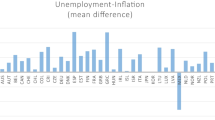Abstract
Previous studies attribute the failure of the expectations theory, using the 3–6-month Treasury bill spread, to the Federal Reserve’s commitment to stabilizing interest rates. We find that with the advent of Greenspan, this spread predicts future changes in the short rate in the USA. This success can be explained by interest rate smoothing and greater transparency by the Fed. By enhancing the management of market expectations and reducing uncertainty, the central bank improves interest rate predictability and gains credibility from the market, as lower term premia suggest.


Similar content being viewed by others
Notes
The start date is chosen to exclude the strict monetary targeting regime during Volcker’s tenure. Previous years were not included due to a lack of data availability.
We find the federal target rate to still be a random walk whose innovations, however, have changed, becoming more predictable. Note that, since the series is a random walk, the graphical representation of residuals from the regression of the target on a constant and its first lagged value would be almost indistinguishable from those in Fig. 1.
Results, omitted for brevity, are available from the author upon request.
This is the evocative title of William Greider’s (1987) bestseller about the Federal Reserve.
A Quandt–Andrews unknown breakpoint test finds the single breakpoint to be in 2004:3.
We do not report results for regressions with too few observations; hence, the last starting date considered is 2005:9.
Swanson (2006), analysing the same period, introduces a variable named “momentum” that signals uncertainty created by rapid changes in the Fed target rate; he finds that this variable spiked in 2001–2 and 1994–95. Even a Bai–Perron multiple breakpoint test finds the years 1994 and 2002 among the possible breakpoints. Results, not reported for brevity, are available from the author upon request.
According to Caporale and Caporale (2003), in the USA, the reduction in interest rate uncertainty brought about by the establishment of the Fed lowered financial market risk, causing a decrease in the risk premium a 6-month instrument pays over a 3-month one from 0.65 before the Fed founding to 0.3 for the period 1914–1933.
Bernanke (2004) stresses this point comparing monetary policy to driving a car whose speed “depends not on the pressure on the accelerator at that moment but rather on the expected average pressure on the accelerator over the rest of the trip.”
References
Bernanke B (2004) The logic of monetary policy. Remarks before the National Economists Club, December 2
Campbell JY (1995) Some lessons from the yield curve. J Econ Perspect 9:124–52
Caporale B, Caporale T (2003) Investigating the effects of monetary regime shifts. The case of the Federal Reserve and the shrinking risk premium. Econ Lett 80:87–91
Ellison M (2006) The learning cost of interest rate reversals. J Monet Econ 53:1895–1907
Favero C, Mosca F (2001) Uncertainty on monetary policy and the expectations model of the term structure of interest rates. Econ Lett 71:369–75
Florio A (2009) Asymmetric preferences for interest rate variability and non-linear monetary policy inertia. Scott J Polit Econ 56:685–704
Fuhrer JC (1996) Monetary policy shifts and long-term interest rates. Q J Econ 111:1183–1209
Greider W (1987) Secrets of the temple: how the federal reserve runs the country. Simon and Schuster, New York
Kugler P (1988) An empirical note on the term structure and interest rate stabilization policies. Q J Econ 103:789–92
Mankiw NG, Miron JA (1986) The changing behavior of the term structure of interest rates. Q J Econ 101:211–28
Rudebusch GD (2002) Term structure evidence on interest rate smoothing and monetary policy inertia. J Monet Econ 49:1161–87
Swanson E (2006) Have increases in Federal Reserve transparency improved private sector interest rate forecasts? J Money Credit Bank 38(3):791–819
Woodford M (1999) Optimal monetary policy inertia. Manch Sch 67(Supplement):1–35
Author information
Authors and Affiliations
Corresponding author
Additional information
Publisher's Note
Springer Nature remains neutral with regard to jurisdictional claims in published maps and institutional affiliations.
Rights and permissions
About this article
Cite this article
Florio, A. Term structure and interest rate stabilization policies in the Greenspan era. Empir Econ 59, 345–355 (2020). https://doi.org/10.1007/s00181-019-01672-x
Received:
Accepted:
Published:
Issue Date:
DOI: https://doi.org/10.1007/s00181-019-01672-x




